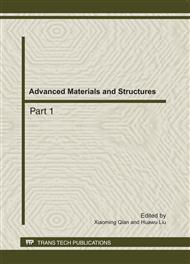[1]
A. Short, W. Kinniburgh. Lightweight Concrete. Third Edition. Applied Science Publishers. London. 1978.
Google Scholar
[2]
B. H. Spratt DLC, FICE, FIHE. An introduction to lightweight concrete. Cement and Concrete Association. (1980)
Google Scholar
[3]
FIP Manual of Lightweight Aggregate Concrete. Second Edition. Surrey University Press. Glasgow and London. (1983)
Google Scholar
[4]
Jamal Alduaij, Khalid Alshaleh. Lightweight concrete in hot coastal areas. Cement and Concrete Composites 21(1999) 453-458.
DOI: 10.1016/s0958-9465(99)00035-9
Google Scholar
[5]
O. Kayali, M.N. Haque, B. Zhu. Drying shrinkage of fibre-reinforced lightweight aggregate concrete containing fly ash. Cement and Concrete Research 29 (1999) 1835–1840
DOI: 10.1016/s0008-8846(99)00179-9
Google Scholar
[6]
Popovics Sandor, Strength and related properties of concrete: a quantitative approach, John Wiley & Sons, Inc., 1998.
Google Scholar
[7]
Swamy R.N.; Lambert G.H. J., Mix design and properties of concrete made from PFA coarse aggregate and sand, International Journal of Cement Composites and Lightweight Concrete, 1983, Vol. 5, No.4, p.263–275.
DOI: 10.1016/0262-5075(83)90068-4
Google Scholar
[8]
Mayfield B.; Louati M., Properties of palletized blastfurnace slag concrete, Magazine of Concrete Research 1990, 42, p.29–36.
DOI: 10.1680/macr.1990.42.150.29
Google Scholar
[9]
Aitcin P.C.; Mehta P.K. J., Effect of Coarse Aggregate Characteristics on Mechanical Properties of High-Strength Concrete, ACI Materials Journal, 1990, 87, 2, p.103–107.
DOI: 10.14359/1882
Google Scholar
[10]
Zhou F.P.; Lydon F.D.; and Barr B.I.G., Effect of coarse aggregate on elastic modulus and compressive strength of high performance concrete, Cement and Concrete Research. 1995, Vol. 25, No. 1, p.177–186.
DOI: 10.1016/0008-8846(94)00125-i
Google Scholar
[11]
Weigle H., Karl S., Mix Ratio Design of Lightweight Aggregate Concrete, Lightweight Aggregate Concrete CEB/FIP Manual of Design and Technology, p.23–47.
DOI: 10.1016/0262-5075(83)90076-3
Google Scholar
[12]
Wang Zhenyu, Long Term Deformation Characteristics and Mechanical Properties of High Strength LWAC, Master thesis, Tsinghua University, (2005)
Google Scholar
[13]
Wang Lijun, et al., Investigation of the mix ratio design of lightweight aggregate concrete, Cement and Concrete Research 35 (2005) 931–935
DOI: 10.1016/j.cemconres.2004.09.029
Google Scholar
[14]
Larrard, F. de, Concrete Mixture Proportioning: a scientific approach, 1999, p.376~377
Google Scholar
[15]
Montgomery D. C., Peck E. A., Introduction to linear regression analysis -2nd edition, A Wiley-Interscience Publication, 1991.
Google Scholar
[16]
CUI H. Z., Mechanical Properties of Lightweight Aggregate Concrete — Effect of Lightweight Aggregate on the Concrete, PhD thesis, City University of Hong Kong, (2006)
Google Scholar
[17]
Yang C. C., and Huang R., A two-phase model for predicting the compressive strength of concrete. Cement and Concrete Research, 1996; 26(10), p.1567–77
DOI: 10.1016/0008-8846(96)00137-8
Google Scholar
[18]
FIP manual of lightweight aggregate concrete (2nd edition), Surrey University Press & Halsted Press, 1983.
Google Scholar


